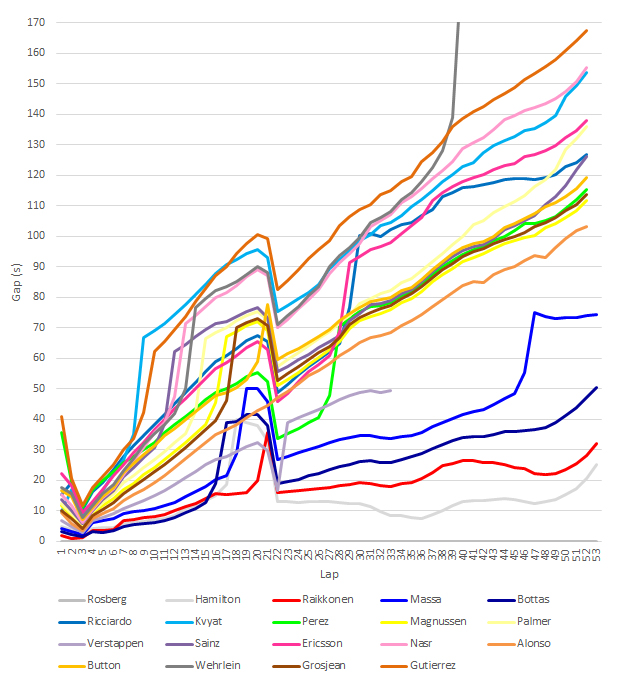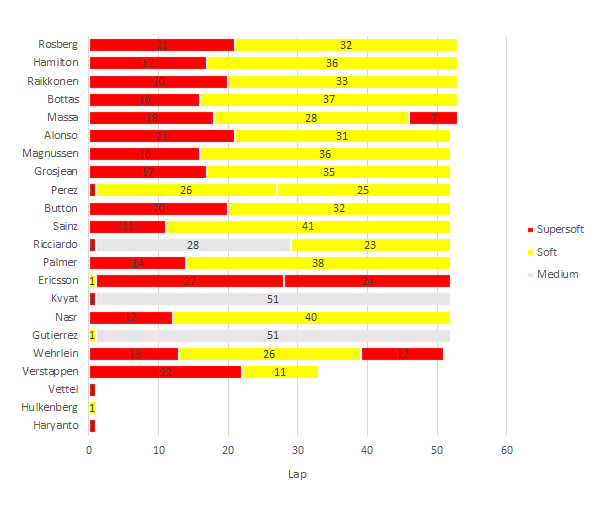Lewis Hamilton clearly had better race pace than Nico Rosberg, but it is highly unlikely that he would have been able to pass his teammate and win the race without his water leak.
That the Briton was quicker is immediately visible between lap 22 and lap 30 on our race chart and again between lap 33 and lap 36 when Rosberg cleared lapped traffic, decided to up his pace again and/or got to grips with his minor MGU-K issue – between lap 30 and lap 33 he lost ground not only versus Hamilton but versus the next four cars as well, so, obviously, he ran below his target lap time in that period for either of the above reasons. Assuming Hamilton was able to keep his remarkable pursuit going, he would have catched Rosberg around lap 45-47 but, on the one hand, he would have had to face with poor passing opportunities and, on the other hand, it is entirely probable that he would have run out of tyre life sooner than Rosberg considering that his tyres were 4 laps older.
Hamilton’s damage limitation was, nevertheless, entirely successful and was rooted in Daniil Kvyat immediately taking out, directly or indirectly, at least three cars (Perez, Vettel, Ricciardo) the Mercedes driver would have had to clear following a decidedly average getaway from 10th on the grid. So even though a water leak kept him from contending for the win, it was not all bad for Hamilton on Sunday. He also did well to pounce on Kimi Raikkonen’s slightest of mistakes and, particularly, to overtake Valtteri Bottas’ Williams which is usually notoriously hard to pass.

Bottas himself also performed admirably to hold station against the Mercedes and Raikkonen during his first stint and brake right on the limit into Turn 2 at the beginning of his second, when Hamilton exited the pits right beside him, to keep his place for one more lap. In the latter move, every millisecond counted, including the 0.15s by which Bottas pitted quicker on lap 16 than Hamilton did on lap 17. It was the 4th quickest stop of the day with Williams claiming the outright quickest (with Felipe Massa) for the fourth time in as many races this year.
Not only did the lap 1 antics help set the stage for Hamilton’s successful recovery, they also eliminated most of the higher midfield contenders as well, enabling Fernando Alonso to score a comfortable 6th, controlling the gap ahead of Haas and Renault easily.
Red Bull probably had the third or fourth best car again (Daniel Ricciardo was much quicker than the Williams late on on the same tyre and with a damaged car, albeit on a shorter stint) but still finished a lowly 12th and 15th on the road thanks to Kvyat’s errors and switching onto the medium compound tyre under the safety car (SC) which turned out to be a mistake as well. Kvyat’s penatly was simply the icing on the cake. Force India and Toro Rosso were also much quicker than Alonso’s McLaren (see Perez’s mid-race pace in clean air) but Perez, Carlos Sainz and Nico Hulkenberg were all caught up in the Turn 2 melee. Sainz lost downforce during his first stint due to debris, hence his poor pace, while Max Verstappen’s power unit expired.

There were a number of interesting tactical moves in the lower midfield. Kevin Magnussen went one better than the relative position he inherited following the Turn 2 calamity by successfully undercutting Romain Grosjean – a close rival pace-wise – during their only stops. Pit stop data reveal that Renault was 0.8s quicker in the pits with the Dane than rookie Haas was with Grosjean.
Magnussen then withstood race-long pressure from the Frenchman with a lower (albeit not much lower) top speed, something teammate Jolyon Palmer failed to do versus his own opponents. He was simply passed by Sainz and Jenson Button soon after his stop while being on the same strategy as Magnussen. On the top of that, even Perez took him (and Button), benefitting from an extended stint on the softs which the Mexican fitted when he stopped for puncture at the end of lap 1. He thus delivered on what began as the same reversed strategy that Hulkenberg, Esteban Gutierrez and Marcus Ericsson – who either hit trouble (Hulkenberg, Gutierrez) or switched plans (Ericsson) – chose at the start.
One of the more controversial moments of the race was when Sainz was penalised for not leaving enough space for Palmer at the exit of Turn 2 after the Briton tried a switchback on him on the inside which became the outside as the pair crossed the track diagonally setting up for Turn 3. The Spaniard did indeed just that – not expecting his rival there, as he said afterwards, does not relieve him –, but Pascal Wehrlein did a carbon copy move against Felipe Nasr on lap 10 and he was not found guilty by the stewards…
The Sauber was otherwise slower than anywhere else this year with Wehrlein able to close in on Nasr again following a successful undercut by the Brazilian. (He did not pass him for a second time, though.)

If need Kimi speed same as Nico!
LikeLike